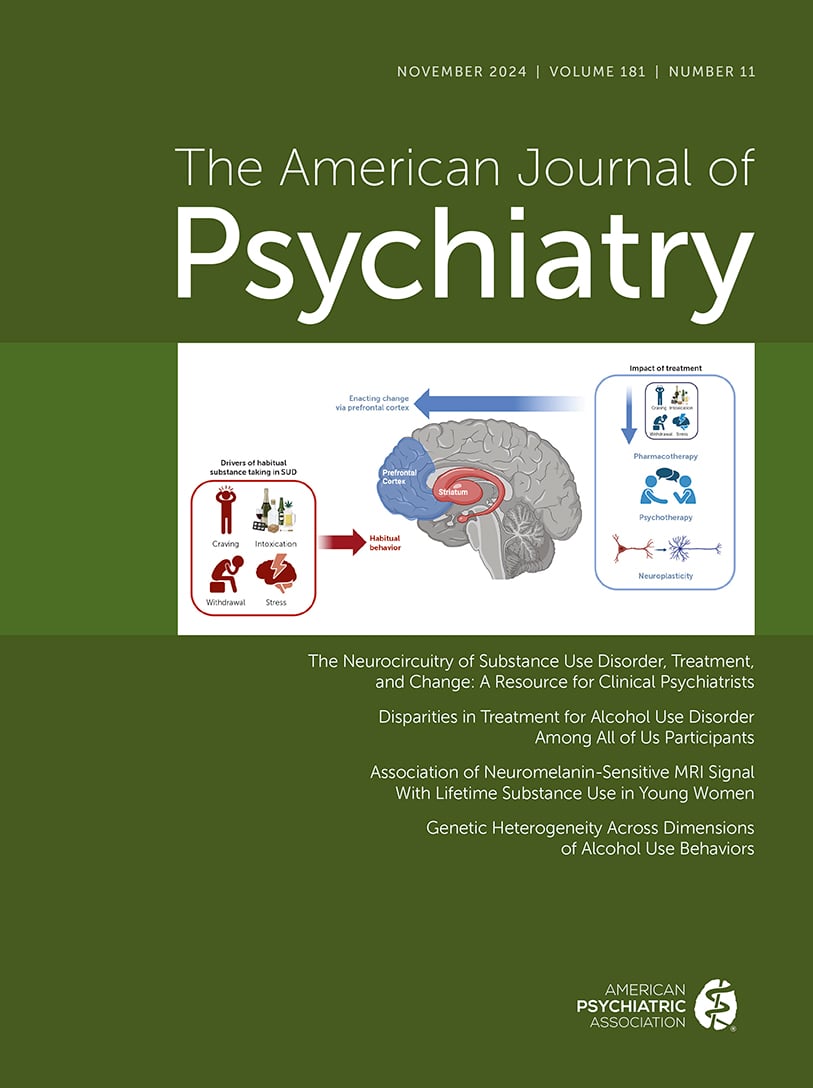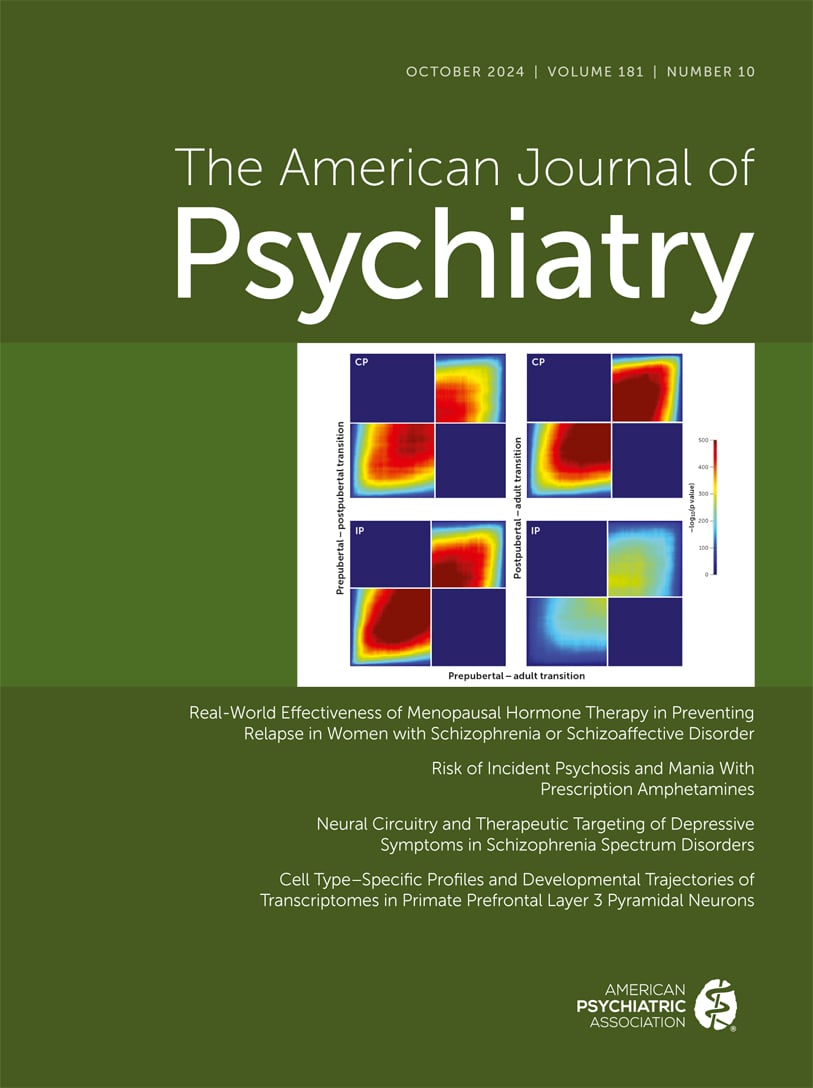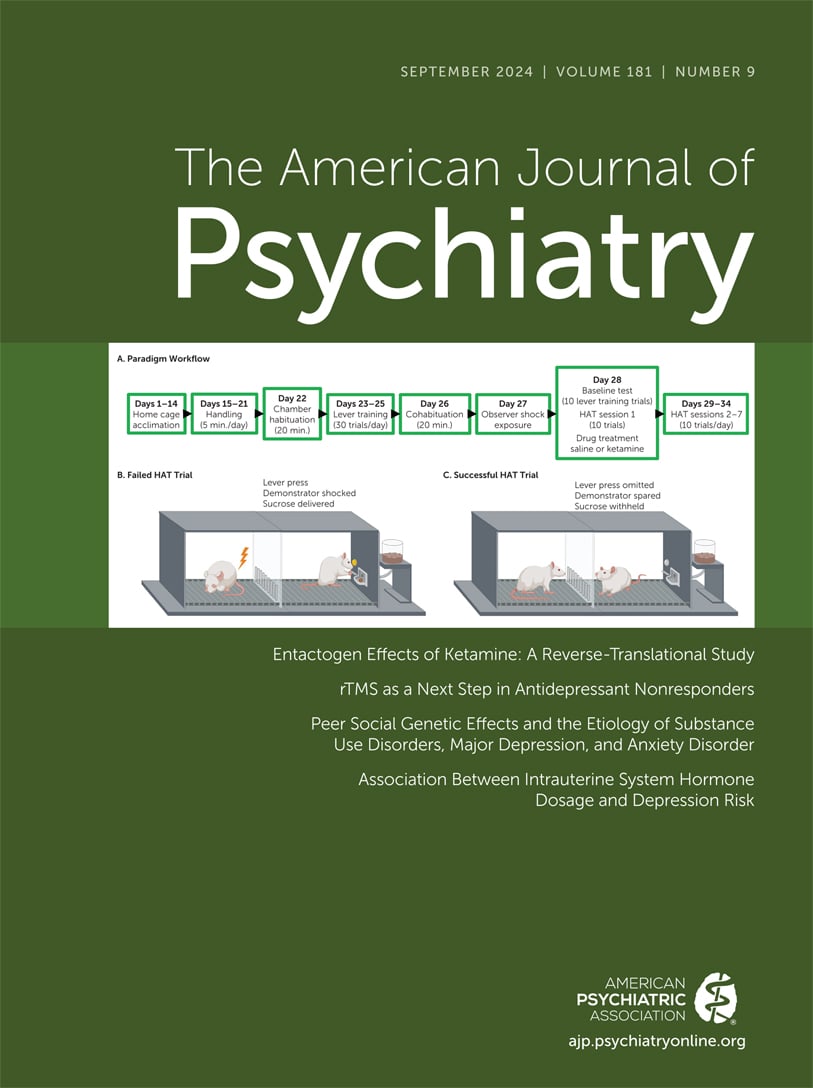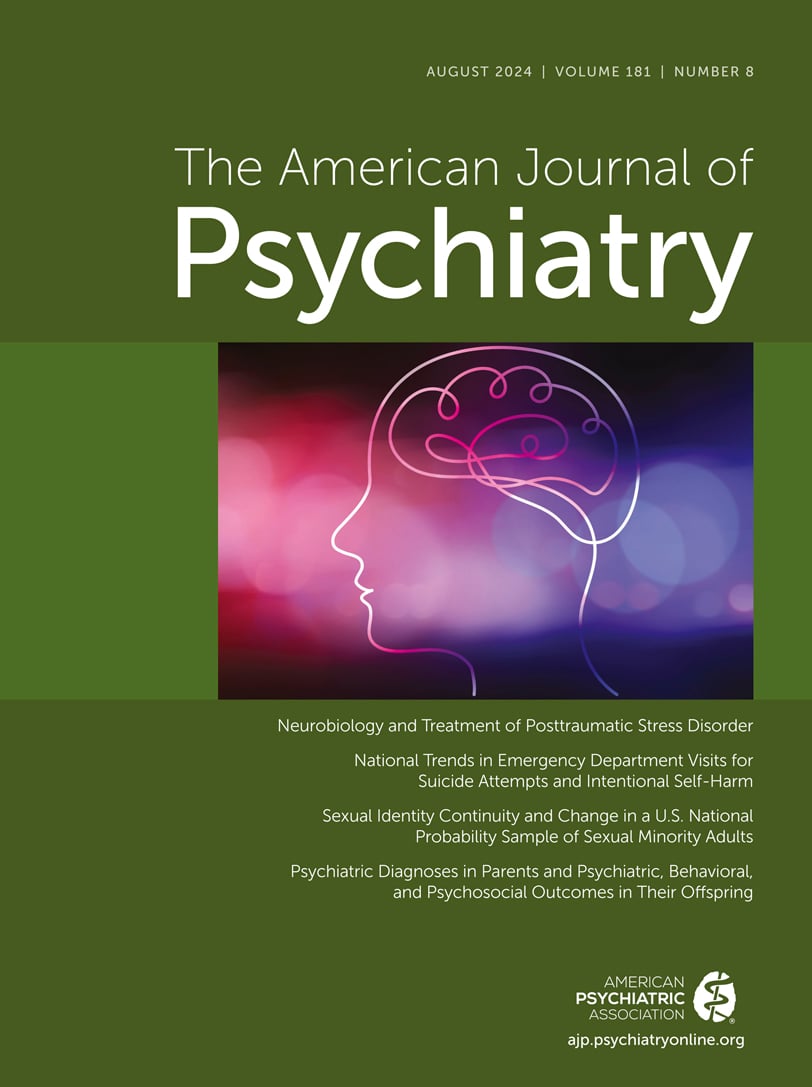American Journal of Psychiatry
- Volume 156
- Number 5
- May 1999
Editorial
Images in Neuroscience
Regular Article
Publication date: 01 May 1999
Pages675–682OBJECTIVE: Theories of human behavior from Plato to Freud have repeatedly emphasized links between emotion and reason, a relationship now commonly attributed to pathways connecting phylogenetically “old” and “new” brain regions. Expanding on this theory, ...
https://doi.org/10.1176/ajp.156.5.675Publication date: 01 May 1999
Pages683–689OBJECTIVE: The treatment of geriatric depression is complicated by a variable and delayed response to antidepressant treatment. The present study was undertaken to test the hypothesis that combined total sleep deprivation and paroxetine treatment would ...
https://doi.org/10.1176/ajp.156.5.683Publication date: 01 May 1999
Pages690–696OBJECTIVE: The rates of antidepressant recommendation and use were determined in outpatients with major depression receiving services in mental health clinics. Site of service and the patients’ sociodemographic and clinical characteristics were ...
https://doi.org/10.1176/ajp.156.5.690Publication date: 01 May 1999
Pages697–701OBJECTIVE: A central assumption underlying managed care is that plan switching is a viable option for enrollees when they are dissatisfied. The authors used a national employee survey to test the hypothesis that this mechanism is less effective for ...
https://doi.org/10.1176/ajp.156.5.697Publication date: 01 May 1999
Pages702–709OBJECTIVE: The primary intent of this study was to compare the efficacy and safety of olanzapine and placebo in the treatment of acute mania. METHOD: The design involved a random-assignment, double-blind, placebo-controlled parallel group study of 3 weeks’...
https://doi.org/10.1176/ajp.156.5.702Publication date: 01 May 1999
Pages710–715OBJECTIVE: Transthyretin plays an important role in the transport and distribution of thyroid hormone in the central nervous system (CNS). This study replicated and extended to patients with nonrefractory depressive illness a pilot study indicating that ...
https://doi.org/10.1176/ajp.156.5.710Publication date: 01 May 1999
Pages716–722OBJECTIVE: Previous studies found functional changes in the frontal brain region and regions with projections to the frontal lobe in cocaine users. The aim of this study was to investigate persistent neurochemical changes in the frontal lobes of subjects ...
https://doi.org/10.1176/ajp.156.5.716Publication date: 01 May 1999
Pages723–732OBJECTIVE: Cross-sectional studies show a robust association between anxiety disorders and alcohol use disorders (comorbidity); however, this methodology does not allow for the testing of causal models. The authors attempted to overcome this limitation by ...
https://doi.org/10.1176/ajp.156.5.723Publication date: 01 May 1999
Pages733–738OBJECTIVE: The purpose of this study was to determine the extent of comorbid substance use disorders in patients referred for treatment of personality disorders. METHOD: Two hundred inpatients and outpatients were assessed by semistructured interviews for ...
https://doi.org/10.1176/ajp.156.5.733Publication date: 01 May 1999
Pages739–744OBJECTIVE: The purpose of this study was to investigate the possibility of a differential sensitivity to CO2 in patients diagnosed with panic disorder subtypes that were defined by the presence of prominent respiratory symptoms. METHOD: The authors used a ...
https://doi.org/10.1176/ajp.156.5.739Publication date: 01 May 1999
Pages745–748OBJECTIVE: Previous studies have suggested that manipulations in patient instructions before inhalation of carbon dioxide (CO2) may blunt its anxiogenic effects. The authors examined the effects of a range of instructional types on panic rates and ...
https://doi.org/10.1176/ajp.156.5.745Publication date: 01 May 1999
Pages749–755OBJECTIVE: This study investigated the relationship between self-reported childhood abuse and dissociative symptoms and amnesia. The presence or absence of corroboration of recovered memories of childhood abuse was also studied. METHOD: Participants were ...
https://doi.org/10.1176/ajp.156.5.749Publication date: 01 May 1999
Pages756–760OBJECTIVE: The purpose of this study was to determine the efficacy of fluvoxamine for the treatment of social phobia (social anxiety disorder). METHOD: In a 12-week multicenter, double-blind, randomized, placebo-controlled trial, 92 patients with social ...
https://doi.org/10.1176/ajp.156.5.756Clinical Case Conference
Images in Psychiatry
Brief Report
Publication date: 01 May 1999
Pages768–770OBJECTIVE: Family, twin, and adoption studies show attention deficit hyperactivity disorder (ADHD) to have a substantial genetic component, and some studies have reported an association between ADHD and the dopamine D4 (DRD4) gene. METHOD: The authors ...
https://doi.org/10.1176/ajp.156.5.768Publication date: 01 May 1999
Pages771–773OBJECTIVE: Small Japanese studies have suggested that patients with schizophrenia have higher rates of the HLA-DR1 gene than normal subjects. The authors’ goal in the present study was to confirm this finding in a larger number of Japanese subjects. They ...
https://doi.org/10.1176/ajp.156.5.771Publication date: 01 May 1999
Pages774–776OBJECTIVE: Tryptophan hydroxylase is the rate-limiting enzyme in the biosynthesis of serotonin. The authors examined whether polymorphisms A218C and A779C in intron 7 of the tryptophan hydroxylase gene are associated with a risk for affective disorders or ...
https://doi.org/10.1176/ajp.156.5.774Publication date: 01 May 1999
Pages777–779OBJECTIVE: The authors’ goal was to evaluate cognition in children with obsessive-compulsive disorder (OCD) early in their illness. METHOD: They administered neuropsychological tests to 21 pediatric patients with OCD and 21 healthy children matched for ...
https://doi.org/10.1176/ajp.156.5.777Publication date: 01 May 1999
Pages780–782OBJECTIVE: Neuroimaging studies have demonstrated reduced prefrontal cortical blood flow and metabolism in depression, but the neurobehavioral significance of these observations is not yet established. METHOD: The Wisconsin Card Sorting Test, a widely ...
https://doi.org/10.1176/ajp.156.5.780Publication date: 01 May 1999
Pages783–785OBJECTIVE: The goal of this study was to evaluate patient and physician acceptance of televideo interviews for general psychiatric assessments. METHOD: DSM-III-R diagnoses for axes I and II were made for 40 patients by using the Structured Clinical ...
https://doi.org/10.1176/ajp.156.5.783Publication date: 01 May 1999
Pages786–788OBJECTIVE: The primary purpose of this research was to assess the rates of axis I and axis II psychiatric disorders, as defined in DSM-IV, in a group of pedophilic sex offenders. METHOD: Forty-five male subjects with pedophilia who were participating in ...
https://doi.org/10.1176/ajp.156.5.786Book Forum: CHILD PSYCHIATRY
Book Forum: GERIATRICS
Book Forum: MANAGED CARE
Book Forum: PSYCHOLOGICAL TRAUMA
Letter to the Editor
Letters To the Editor
Past Issues
View Issues Archive
Vol. 181 | No. 11

Vol. 181 | No. 10

Vol. 181 | No. 9
